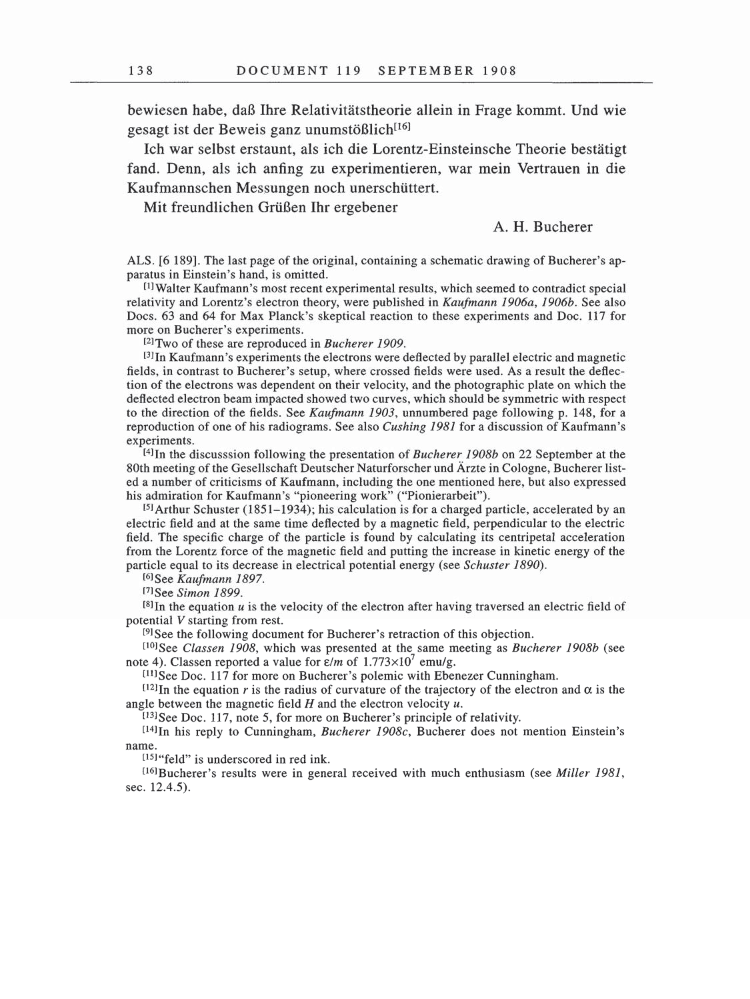138 DOCUMENT 119 SEPTEMBER 1908 bewiesen habe, daß Ihre Relativitätstheorie allein in Frage kommt. Und wie gesagt ist der Beweis ganz unumstößlich[16] Ich war selbst erstaunt, als ich die Lorentz-Einsteinsche Theorie bestätigt fand. Denn, als ich anfing zu experimentieren, war mein Vertrauen in die Kaufmannschen Messungen noch unerschüttert. Mit freundlichen Grüßen Ihr ergebener A. H. Bucherer ALS. [6 189]. The last page of the original, containing a schematic drawing of Bucherer's ap- paratus in Einstein's hand, is omitted. [1]Walter Kaufmann's most recent experimental results, which seemed to contradict special relativity and Lorentz's electron theory, were published in Kaufmann 1906a, 1906b. See also Docs. 63 and 64 for Max Planck's skeptical reaction to these experiments and Doc. 117 for more on Bucherer's experiments. [2]Two of these are reproduced in Bucherer 1909. [3]In Kaufmann's experiments the electrons were deflected by parallel electric and magnetic fields, in contrast to Bucherer's setup, where crossed fields were used. As a result the deflec- tion of the electrons was dependent on their velocity, and the photographic plate on which the deflected electron beam impacted showed two curves, which should be symmetric with respect to the direction of the fields. See Kaufmann 1903, unnumbered page following p. 148, for a reproduction of one of his radiograms. See also Cushing 1981 for a discussion of Kaufmann's experiments. [4]In the discusssion following the presentation of Bucherer 1908b on 22 September at the 80th meeting of the Gesellschaft Deutscher Naturforscher und Ärzte in Cologne, Bucherer list- ed a number of criticisms of Kaufmann, including the one mentioned here, but also expressed his admiration for Kaufmann's "pioneering work" ("Pionierarbeit"). [5]Arthur Schuster (1851-1934) his calculation is for a charged particle, accelerated by an electric field and at the same time deflected by a magnetic field, perpendicular to the electric field. The specific charge of the particle is found by calculating its centripetal acceleration from the Lorentz force of the magnetic field and putting the increase in kinetic energy of the particle equal to its decrease in electrical potential energy (see Schuster 1890). [6]See Kaufmann 1897. [7]See Simon 1899. [8]In the equation u is the velocity of the electron after having traversed an electric field of potential V starting from rest. [9]See the following document for Bucherer's retraction of this objection. [10]See Classen 1908, which was presented at the same meeting as Bucherer 1908b (see note 4). Classen reported a value for e/m of 1.773xl07 emu/g. [11]See Doc. 117 for more on Bucherer's polemic with Ebenezer Cunningham. [12]In the equation r is the radius of curvature of the trajectory of the electron and a is the angle between the magnetic field H and the electron velocity u. [13]See Doc. 117, note 5, for more on Bucherer's principle of relativity. [14]In his reply to Cunningham, Bucherer 1908c, Bucherer does not mention Einstein's name. [15]"feld" is underscored in red ink. [16]Bucherer's results were in general received with much enthusiasm (see Miller 1981, sec. 12.4.5).
